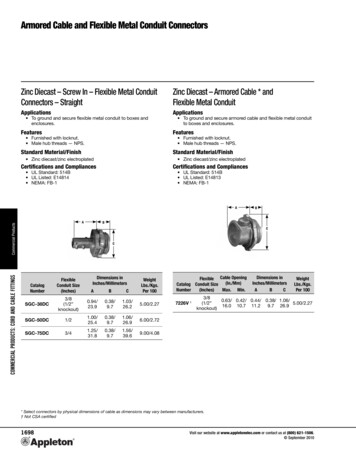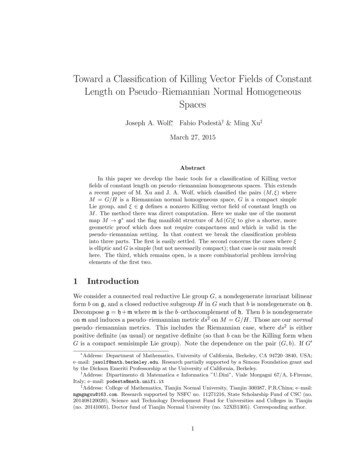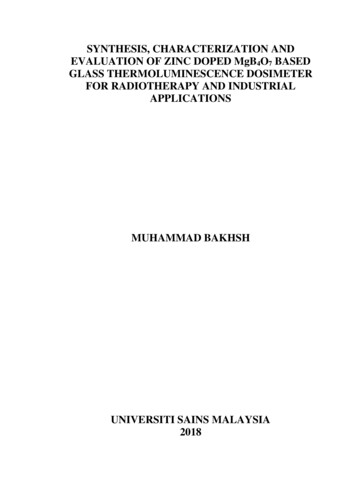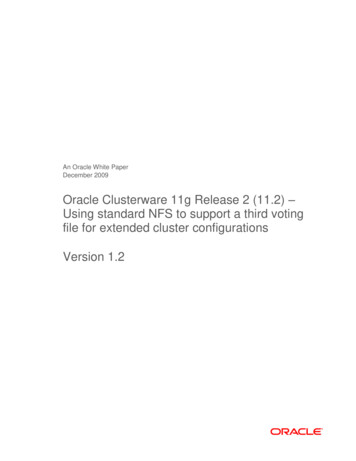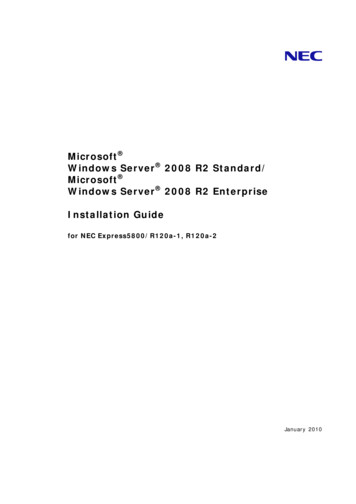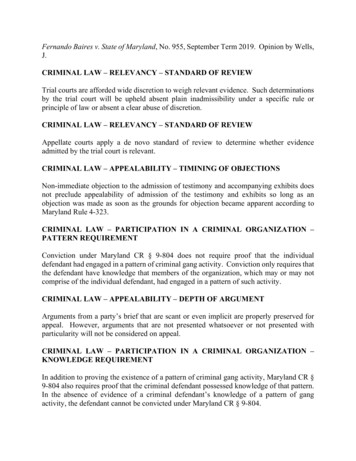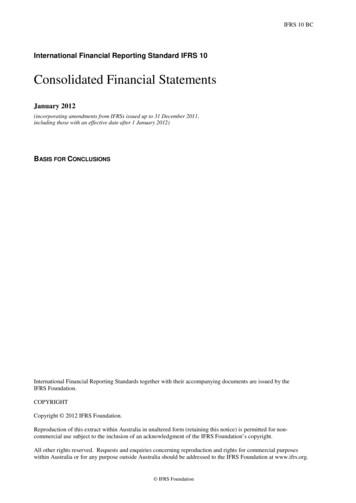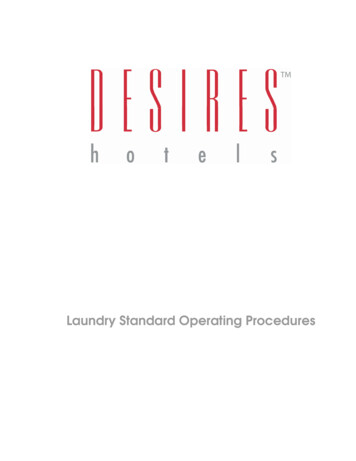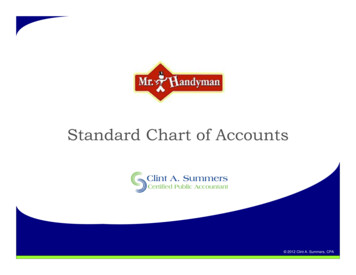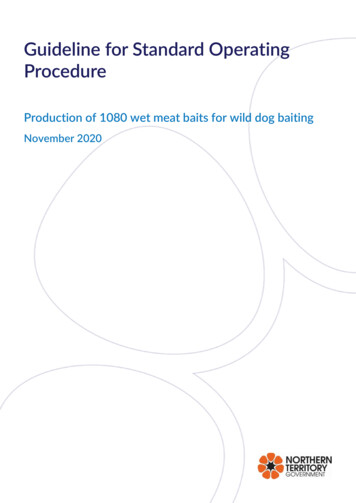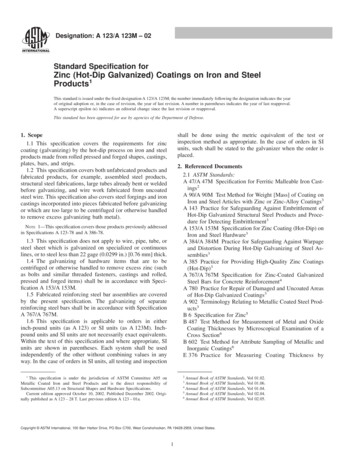
Transcription
Designation: A 123/A 123M – 02Standard Specification forZinc (Hot-Dip Galvanized) Coatings on Iron and SteelProducts1This standard is issued under the fixed designation A 123/A 123M; the number immediately following the designation indicates the yearof original adoption or, in the case of revision, the year of last revision. A number in parentheses indicates the year of last reapproval.A superscript epsilon (e) indicates an editorial change since the last revision or reapproval.This standard has been approved for use by agencies of the Department of Defense.shall be done using the metric equivalent of the test orinspection method as appropriate. In the case of orders in SIunits, such shall be stated to the galvanizer when the order isplaced.1. Scope1.1 This specification covers the requirements for zinccoating (galvanizing) by the hot-dip process on iron and steelproducts made from rolled pressed and forged shapes, castings,plates, bars, and strips.1.2 This specification covers both unfabricated products andfabricated products, for example, assembled steel products,structural steel fabrications, large tubes already bent or weldedbefore galvanizing, and wire work fabricated from uncoatedsteel wire. This specification also covers steel forgings and ironcastings incorporated into pieces fabricated before galvanizingor which are too large to be centrifuged (or otherwise handledto remove excess galvanizing bath metal).2. Referenced Documents2.1 ASTM Standards:A 47/A 47M Specification for Ferritic Malleable Iron Castings2A 90/A 90M Test Method for Weight [Mass] of Coating onIron and Steel Articles with Zinc or Zinc-Alloy Coatings3A 143 Practice for Safeguarding Against Embrittlement ofHot-Dip Galvanized Structural Steel Products and Procedure for Detecting Embrittlement3A 153/A 153M Specification for Zinc Coating (Hot-Dip) onIron and Steel Hardware3A 384/A 384M Practice for Safeguarding Against Warpageand Distortion During Hot-Dip Galvanizing of Steel Assemblies3A 385 Practice for Providing High-Quality Zinc Coatings(Hot-Dip)3A 767/A 767M Specification for Zinc-Coated GalvanizedSteel Bars for Concrete Reinforcement4A 780 Practice for Repair of Damaged and Uncoated Areasof Hot-Dip Galvanized Coatings3A 902 Terminology Relating to Metallic Coated Steel Products3B 6 Specification for Zinc5B 487 Test Method for Measurement of Metal and OxideCoating Thicknesses by Microscopical Examination of aCross Section6B 602 Test Method for Attribute Sampling of Metallic andInorganic Coatings6E 376 Practice for Measuring Coating Thickness byNOTE 1—This specification covers those products previously addressedin Specifications A 123-78 and A 386-78.1.3 This specification does not apply to wire, pipe, tube, orsteel sheet which is galvanized on specialized or continuouslines, or to steel less than 22 gage (0.0299 in.) [0.76 mm] thick.1.4 The galvanizing of hardware items that are to becentrifuged or otherwise handled to remove excess zinc (suchas bolts and similar threaded fasteners, castings and rolled,pressed and forged items) shall be in accordance with Specification A 153/A 153M.1.5 Fabricated reinforcing steel bar assemblies are coveredby the present specification. The galvanizing of separatereinforcing steel bars shall be in accordance with SpecificationA 767/A 767M.1.6 This specification is applicable to orders in eitherinch-pound units (as A 123) or SI units (as A 123M). Inchpound units and SI units are not necessarily exact equivalents.Within the text of this specification and where appropriate, SIunits are shown in parentheses. Each system shall be usedindependently of the other without combining values in anyway. In the case of orders in SI units, all testing and inspection21This specification is under the jurisdiction of ASTM Committee A05 onMetallic Coated Iron and Steel Products and is the direct responsibility ofSubcommittee A05.13 on Structural Shapes and Hardware Specifications.Current edition approved October 10, 2002. Published December 2002. Originally published as A 123 – 28 T. Last previous edition A 123 – BookBookofofofofofASTMASTMASTMASTMASTMCopyright ASTM International, 100 Barr Harbor Drive, PO Box C700, West Conshohocken, PA 19428-2959, United 05.
A 123/A 123M – 023.2.2 black, adj—denotes the condition of not galvanized orotherwise coated. For purposes of this specification the word“black” does not refer to the color or condition of surface, or toa surface deposit or contamination.3.2.3 coating thickness grade, n—the numerical value fromTable 1 at the intersection of a material category and athickness range.3.2.4 gross dross inclusions, n—the iron/zinc intermetallicspresent in a galvanized coating in a form other than finelydispersed pimples.3.2.4.1 Discussion—These inclusions would create an exposed steel spot if they were removed from the coating. Theseinclusions are raised surfaces and are easily knocked offMagnetic-Field or Eddy-Current (Electromagnetic) TestMethods73. Terminology (See Fig. 1)3.1 Definitions:3.1.1 The following terms and definitions are specific to thisspecification. Terminology A 902 contains other terms anddefinitions relating to metallic-coated steel products.3.2 Definitions of Terms Specific to This Standard:3.2.1 average coating thickness, n—the average of threespecimen coating thicknesses.7Annual Book of ASTM Standards, Vol 03.03.FIG. 1 Single- and Multi-Specimen Articles2
A 123/A 123M – 02TABLE 1 Minimum Average Coating Thickness Grade by Material CategoryAll Specimens TestedSteel Thickness Range (Measured), in. (mm)Material Category 1 16 ( 1.6)Structural Shapes and PlateStrip and BarPipe and TubingWire45454535 1 16to 1 8 (1.6 to 3.2)65654550 to 3 16 (3.2 to 4.8) 3 16 to 1 4 ( 4.8 to 6.4) 1 4 ( 6.4)75757560858575651001007580183.2.10 specimen coating thickness, n—the average thickness from no less than five test measurements on a specimen,when each measurement location is selected to provide thewidest dispersion (in all applicable directions) of locations forthe steel category of the test article within the confines of thespecimen volume.3.2.11 test article, n— an individual unit of product that isa member of the sample and that is examined for conformanceto a part of this specification.through contact with lifting straps or chains, tools, fixtures, orother galvanized parts.3.2.5 material category, n—the general class or type ofmaterial or process of manufacture, or both, that nominallydescribes a unit of product, or from which a unit of product ismade. For example, bar grating belongs to the category “strip,”handrail belongs to the category “pipe,” etc.3.2.6 multi-specimen article, n—a unit of product whosesurface area is greater than 160 in.2[100 000 mm2]. Forthickness testing purposes, articles whose surface area isgreater than 160 in.2 are subdivided into three continuous localsections, nominally equal in surface area, each of whichconstitutes a specimen. In the case of any such local sectioncontaining more than one material category or steel thicknessrange as delineated in Table 1, that section will contain morethan one specimen (see Fig. 1).3.2.7 sample, n—a collection of individual units of productfrom a single lot selected in accordance with Section 7, andintended to represent that lot for acceptance. If a sample istaken as representing the lot for acceptance, the sample shall betaken at random from the lot without regard to the perceivedquality or appearance of any individual unit in the lot beingsampled. The sample consists of one or more test articles.3.2.8 single-specimen article, n—a unit of product whosesurface area is equal to or less than 160 in.2 [100 000 mm2] orthat is centrifuged or otherwise similarly handled in thegalvanizing process to remove excess galvanizing bath metal(free zinc). For thickness testing purposes, the entire surfacearea of each unit of product constitutes a specimen. In the caseof any such article containing more than one material categoryor steel thickness range as delineated in Table 1, that articlewill contain more than one specimen (see Fig. 1).3.2.9 specimen, n— the surface of an individual test articleor a portion of a test article, upon which thickness measurements are to be performed, which is a member of a lot, or amember of a sample representing that lot. For magneticthickness measurements, specimen excludes any area of thesurface which is subject to processes (such as flame cutting,machining, threading, etc.) that can be expected to result insurface conditions not representative of the general surfacecondition of the test article, or is disqualified by the measurement method. The minimum average coating thickness gradefor any specimen shall be one coating grade below thatrequired for the appropriate material category and thickness inTable 1. For a unit of product whose surface area is equal to orless than 160 in.2 [100 000 mm2], the entire surface area ofeach test article constitutes a specimen. In the case of an articlecontaining more than one material category or steel thicknessrange as delineated in Table 1, that article will contain morethan one specimen, as appropriate (see Fig. 1).4. Ordering Information4.1 Orders for coatings provided under this specificationshall include the following:4.1.1 Quantity (number of pieces to be galvanized) and totalweight.4.1.2 Description (type and size of products) and weight.4.1.3 ASTM specification designation and year of issue.4.1.4 Material identification (see 5.1) and surface conditionor contamination.4.1.5 Sampling plan, if different from 7.3.4.1.6 Special test requirements (see 8.1).4.1.7 Special requirements (special stacking, heavier coating weight, etc.).4.1.8 Tagging or piece identification method.5. Materials and Manufacture5.1 Steel or Iron—The specification, grade, or designationand type and degree of surface contamination of the iron orsteel in articles to be galvanized shall be supplied by thepurchaser to the hot-dip galvanizer prior to galvanizing.NOTE 2—The presence in steels and weld metal, in certain percentages,of some elements such as silicon, carbon, and phosphorus tends toaccelerate the growth of the zinc-iron alloy layer so that the coating mayhave a matte finish with little or no outer zinc layer. The galvanizer hasonly limited control over this condition. The mass, shape, and amount ofcold working of the product being galvanized may also affect thiscondition. Practice A 385 provides guidance on steel selection anddiscusses the effects of various elements in steel compositions (forexample, silicon), that influence coating weight and appearance.5.2 Fabrication—The design and fabrication of the productto be galvanized are the responsibilities of the designer and thefabricator. Practices A 143, A 384, and A 385 provide guidancefor steel fabrication for optimum hot dip galvanizing and shallbe complied with in both design and fabrication. Consultationbetween the designer, fabricator, and galvanizer at appropriatestages in the design and fabrication process will reduce futureproblems.5.3 Castings—The composition and heat treatment of ironand steel castings shall conform to specifications designated bythe purchaser. Some types of castings have been known to3
A 123/A 123M – 02show potential problems with predisposition to being embrittled during the normal thermal cycle of hot-dip galvanizing.It is the responsibility of the purchaser to heat treat orotherwise allow for the possibility of such embrittling phenomena. The requirements for malleable iron castings to begalvanized shall be as stated in Specification A 47.5.4 Zinc—The zinc used in the galvanizing bath shallconform to Specification B 6. If a zinc alloy is used as theprimary feed to the galvanizing bath, then the base materialused to make that alloy shall conform to Specification B 6.5.5 Bath Composition—The molten metal in the workingvolume of the galvanizing bath shall contain not less than anaverage value of 98.0 % zinc by weight.NOTE 1—Each specimen comprises nominally one third of the totalsurface area of the article. A minimum of five measurements should bemade within the volume of each specimen, as widely dispersed within thatvolume as is practical, so as to represent as much as possible, the generalcoating thickness within that specimen volume.NOTE 3—The galvanizer may choose to add trace amounts of certainelements (for example, aluminum, nickel, and tin) to the zinc bath to helpin the processing of certain reactive steels or to enhance the cosmeticappearance of the finished product. The use of these trace elements ispermitted provided that the bulk chemistry of the galvanizing bath is atleast 98.0 % zinc by weight. The elements can be added to the galvanizingbath as part of a pre-alloyed zinc feed, or they can be added to the bath bythe galvanizer using a master feed alloy.FIG. 2 Articles Made of Many Componentsaverage for each test article shall average not less than onecoating grade below that required in Table 1.6.1.2 For articles whose surface area is equal to or less than160 in.2 [100 000 mm2] (single-specimen articles), the averageof all test articles in the sample must meet the appropriateminimum average coating thickness grade requirements ofTable 1, and for each test article, its specimen coating thicknessshall be not less than one coating grade below that required inTable 1.6.1.3 No individual measurement, or cluster of measurements at the same general location, on a test specimen shall because for rejection under the coating thickness requirements ofthis specification provided that when those measurements areaveraged with the other dispersed measurements to determinethe specimen coating thickness grade for that specimen, therequirements of 6.1.1 or 6.1.2, as appropriate are met.6. Coating Properties6.1 Coating Thickness—The average thickness of coating
2.1 ASTM Standards: A 47/A 47M Specification for Ferritic Malleable Iron Cast-ings2 A 90/A 90M Test Method for Weight [Mass] of Coating on Iron and Steel Articles with Zinc or Zinc-Alloy Coatings3 A 143 Practice for Safeguarding Against Embrittlement of Hot-Dip Galvanized Structural Steel Products and Proce- dure for Detecting Embrittlement3 A 153/A 153M Specification for Zinc Coating (Hot .
